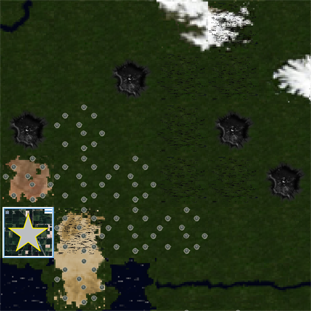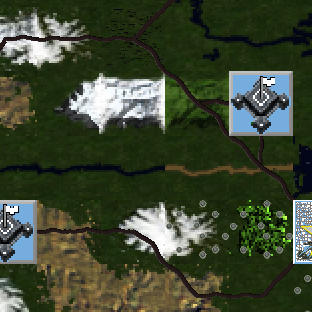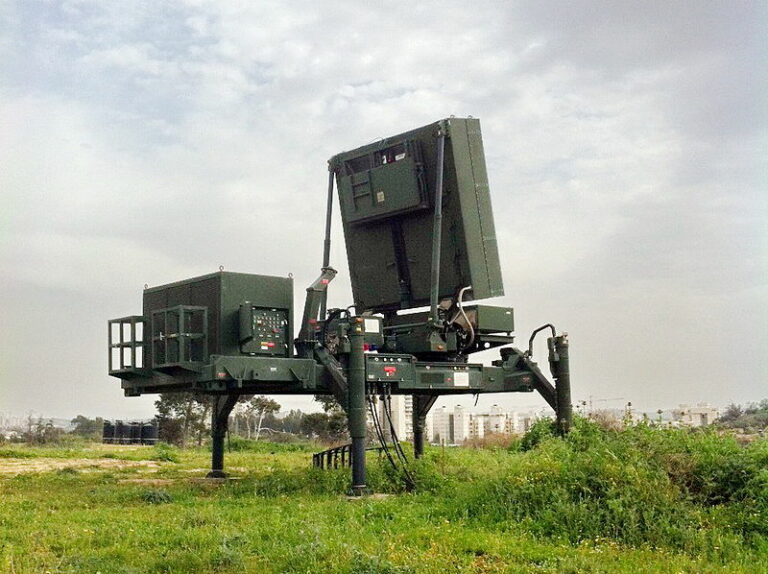What MUD Tells Us About Ukraine – Naval Warfare
The ongoing War in Ukraine offers an opportunity to review the accuracy of the Modern Units Database. At the same time, it gives a unique perspective on what is happening in the war. Let’s take a look at some of the military events that occurred and see if we can understand what is happening through the lens of the Modern Units Database.
In the last Ukraine related post, we covered the opening strategies of the Russian invasion. Like I stated in that post, this will focus purely on military analysis. Politics and humanitarian considerations are not a part of this analysis. With that said, let’s open this new segment by reviewing the naval component of the war and see what the Modern Units Database can teach us.
Naval Geographies Matter
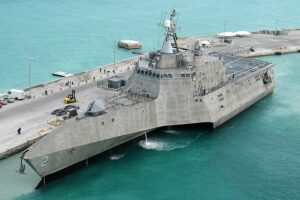
The Gulf War was one of the game changing military events of the modern era. Among the many advancements tested and verified in air and ground combat, the navy experienced many innovations as well. One quiet but important debate in the naval combat arena was the importance of littorals, better understood as the area of water where the power of capital ships is needed but close enough to be targeted by shore-based defense systems. The result was an R&D effort that mirrored the one that led Germany to create Pocket Battleships prior to World War II. While the reason for the R&D race was due to different circumstances, the results were about return on investment.
In the modern example, the result was the creation of the LCS, which was of questionable use at the time. However, the reason for its existence, to make a cannon fodder version of capital ships, was a reinforcement of an age old idea that naval geographies matter, which I refer to as “Naval Theaters.” For the uninitiated, naval assets are generally lumped into three categories:
- Brown Water – These are ships that operate close to shores and in rivers where the water is most likely to be “brown.” If a landlocked country has a Brown Water Navy, it means its maritime force is mostly patrolling rivers.
- Green Water – This is sometimes referred to as the “littorals” and represents waters that are close to shore but not on the shore. Ships in this category typically lack long-range force projection but can often influence a combat zone. If you ever see a patrolling warship video from a land-based location, it’s likely the ship was operating in the green zone.
- Blue Water – These ships are rarely, if ever, seen from the shore. They are usually very expensive multi-system platforms that can do a wide range of activities. However, they typically lack armor and defenses that close-range ships would have, instead relying on their unpredictable and constantly moving nature for defense.
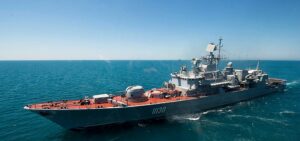
What this means in terms of the War in Ukraine is that any blue water vessel in the Russian Navy should never be seen from land. Ever. In fact, any footage of a capital ship from the Russian Navy should only come from a Russian source. If there is ever a case where a capital ship appears near shore, then something is probably going wrong. However, that doesn’t mean they won’t be operating in the combat zone, just that their distance will remain at or just beyond the horizon.
That should give some insight in terms of how Russia views its ships. On the Ukrainian side, they operate an almost exclusive Brown Water navy. This puts them at a significant disadvantage because they will never be able to outclass the Russian surface fleet. Moreover, if Russia wanted to be reckless, it’s possible for ships to operate in a lower theater than their designated one, but the same is not always true in reverse. In fact, when Ukraine lost the Hetman Sahaidachny (a blue water Frigate) it lost all of its off-coast operation capability. The reason why this wasn’t as big of a concern for Ukraine is due to the strategic location of the Black Sea, which has access limitations. Thus, while it is blue water in size, it is green water in strategic nature for both sides of the conflict.
Ship Losses Are Expensive
The Russian landing ship that was damaged at Berdiansk was expensive to watch. Even if we discount the land-based losses, as well as any potential cargo on board, the fact that three ships were taken out of the conflict was costly. However, while the western media are quick to alert the public to this fact, it’s also important to know that these ships are probably doing what they were designed to do.
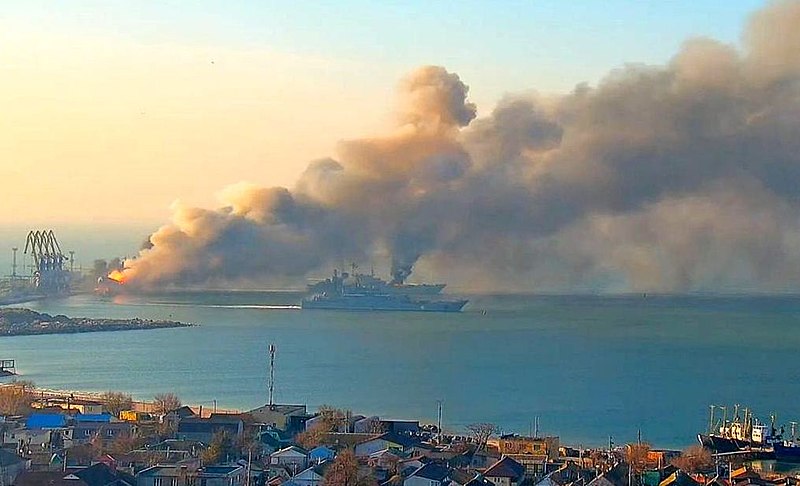
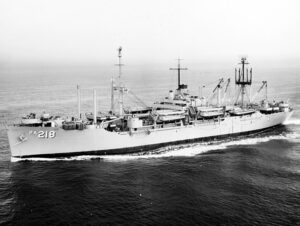
Landing ships come in two flavors. First, the earliest version of a landing ship in the sense of how they are used today, were the Longboats. While there are few early examples of the concept being tried while under fire, the idea was that rowboats can offload troops from a “transport” ship that provides supporting fire while the landing is in progress. In reality, it was easier to just offload the troops at a safe distance then walk. It wouldn’t be until World War II that this concept would get a thorough update. It was during this war that the concept of Attack Transports, or “motherships” carrying purpose build landing craft, would be used in troop landings directly against fortified enemy positions.
The second type is to is to have stand-alone ships perform landings, even if it meant writing them off afterwards. This let to a ship type called “landing docks” that could perform all of actions required of an amphibious assault at the same time. Ironically, this tactic was invented during World War II but not strictly by western countries. The concept is born from the Japanese who found that amphibious landing under fire was required in order to capture island chains. To be successful, the ship had to provide fire support and be protected from land-based weapon systems. At first, the IJN was unprepared for this, but quickly found that cheap armored destroyers could be beached and were very effective at providing this capability for as long as needed. The allies were the first to build true purpose-built LCU’s though, although the limited range meant they couldn’t perform actions outside of their designs, unlike the Japanese destroyers.
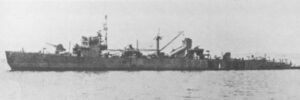
After the war, navies across the world merged the two concepts and created new amphibious assault doctrines. The irony of this photo is that two of these concepts, both with roots in the lessons learned from World War II, are present. The first is the Landing Ship Tank (LST) and the second is the Landing Ship Dock (LSD). Ideally both are situated for front-line “green water” service, but the dock is considerably more advanced as a concept and also more expensive.Inversely, the LST is expected to repel land-based fire as it can drop armored vehicles directly into a combat zone.
If we look at the cost of these units in MUD, the LST costs 110 points while the LSD is 714 points. Keep in mind that these are the average costs for the category. However, an LST has twice the defensive capability, meaning it is meant to take the brunt of combat damage, whereas an LSD is not as resilient. If we consider that Ukraine probably used a ballistic missile to hit these ships, that means that it knocked out over 1,500 points from the war using a missile that cost around 60 points. That’s a really nice tradeoff, one which demonstrates why Ukraine deserves the media attention it received.
Was It Unexpected and Decisive
In MUD terms, the outcome isn’t all that unexpected. The media are painting a painful picture of incompetence over this, and while there is probably some truth to it, the portrayal is overstated. The main issue is why was the LST docked like this? While I’ve never personally boarded an Alligator Class LST, I’ve been on several western ones. One of the first things you notice on any kind of rapid deployment craft is that these ships are suited for drop and go style combat. LST’s can effectively beach themselves and then pull back into safe waters at will. That means if this ship was deploying equipment, it didn’t need a port facility to offload the materials unless it was carrying (or reloading) on fuel.
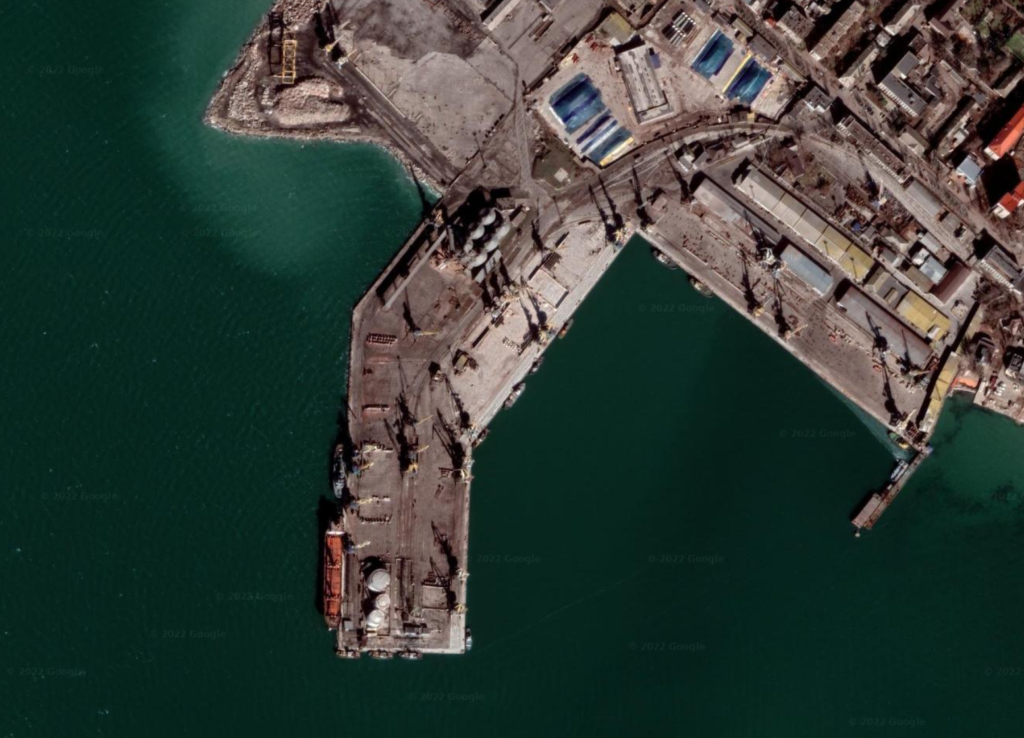
If we assume for a moment that the LST ship was on/offloading fuel, it doesn’t explain why the LSD’s were nearby. This is where the incompetence comes in. The only excuse I can think of is the Russian Navy got complacent, assuming no attack was possible, and decided that this port was the best location to deploy troops to a nearby theater. The other consideration is the ship wasn’t loaded with materials for an amphibious assault, but instead was being used as a moored supply ship. If this is the case, then the ships were being grossly underutilized for their purpose, which may indicate a more severe problem for the fleet overall (or an overabundance of this ship type in the area, thus expendable).
Of the three ships pictured, the two LSD’s have more of a reason to be here than the LST. The fact that both survived, albeit damaged, is due to quick thinking on behalf of their commanders. Satellite images a day later showed them using the proper procedures for fire control keeping them out at sea until the danger passes. If they weren’t actively loading/unloading, this is what they should have been doing all along.
Analysis aside, my opinion based on the data is that these ships were being used as supply depots and not in their combat capacity. If so, the way in which Russia was using them was an unfortunate waste. I would argue that, for the role it was fulfilling, this was a costly loss for Russia. If a combat capable LST is being used as a supply ship, its an expensive loss for Russia. If the LST had been moving troops along the coastline, and was lost in the process, it would have been an inexpensive loss.
Either way, the ship represents hundreds of production points in the MUD system, and ships are hard to re-build during wartime. That means that the loss of the ship represents a permanent loss to the forces of Russia that cannot be regained during the course of the war. Russia got lucky that its two LSD’s survived, but their utility for the remainder of the war, especially in the short term, is questionable at best.
Blue Navy Losses
Then there is the loss of the Moskva. This was an absolutely devastating attack and represents a strategic blunder that should never have happened. However, if you were paying attention to the video footage from Snake Island at the start of the war, you could guess that something like this was going to happen. After all, if you look back at the water types from the first section, it’s pretty clear that something was wrong here.
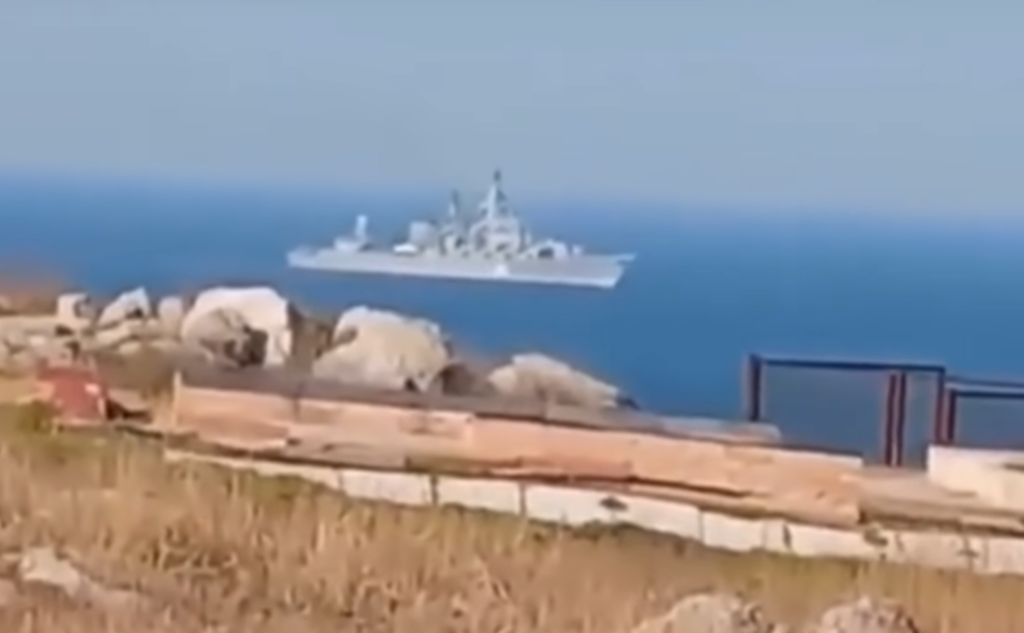
In MUD terms, the Moskva falls into the Frigate category and represents at least 1,707 points, possibly up to 3,000 (EDIT: cost estimated increased to 3,100 after evaluation). To put that in perspective, this one ship is worth more points than the entire fleet damaged/destroyed at Berdiansk. That number also doesn’t include any of the cruise missiles it likely had on board at the time as well. If you take those missiles into account, and assume lowest quality missile frigate, it’s the same as Russia losing 400 Main Battle Tanks (EDIT: Adjusted to 680 MBT’s after evaluation) in a single strike. That is a huge loss of combat potential, even if the ship returns to combat in the long term. Based on preliminary reports, the ship is at least out for the remainder of the Ukraine conflict.
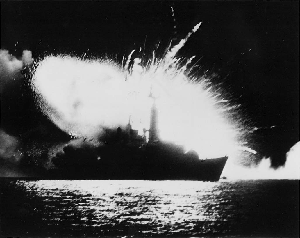
As stated earlier, there is some precedent here. The Russian Navy’s doctrine typically allows ships to operate closer to shorelines than many western ones. The reason is likely due to lack of experience in situations where a ship operating so close to shore was threatened by an enemy force. In fact, if we look at one of the world’s most experienced navies, the Royal Navy of course, you can note that during the Falklands, the Admiralty knew the types of losses they were going to take by landing at San Carlos before the Argentinians even made their attempt to sink them. This is a case of strong awareness of how capable shore and air based anti-ship missiles can be when ships are confined to tight maneuvering spaces. Because Russia doesn’t perform many amphibious assaults, they aren’t aware of these dangers.
Moreover, there is some evidence that the refit of the ship didn’t go according to plan in 2020. As a result, it’s possible that the Russian Navy viewed this Moskva as an obsolete ship and thus expendable. This thinking would be similar role to that pre-dreadnought battleships did in the Dardanelles during World War One, in that they are due to for retirement so it doesn’t matter if they are lost. However, Russia’s Black Sea Fleet is significantly under-powered and as a result the impact of losing a frigate represents a huge loss in its overall fighting effectiveness. Moreover, it will be interesting to see if the volume of cruise missiles decreases as a result of the ship being knocked out of the theater.
The problem with this is the same as the Royal Navy in World War One. It’s about perception. In 1916, the loss of so many ships cost Churchill his role within the Admiralty. While it’s still too soon to know the results of the Moskva, Ukraine has already gained a morale victory as this was the ship that attacked Snake Island and became a prime target for Ukranian propaganda. Regardless of what caused the incident, if the ship ends up sinking the Russian Navy’s reputation will likely suffer permanent damage, much like it did after Tsushima over a hundred years ago.
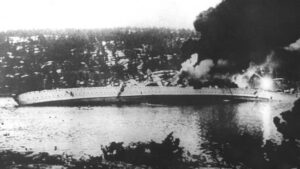
This perception of obsolescence is further supported by how reckless the Russians were with this warship. The fact that video footage from Snake Island clearly showed the ship within point blank range, meaning small arms could have hit it. This is very different than being on the horizon where only missiles are effective. A frigate of this type, which is capable of using cruise missiles, should have been at horizon distance at best. This is an indication that either Russia is in a bad position with their surface fleet, or that the Russians are acting over-confident in the same way the Germans were at Drobak Sound when they lost a heavy cruiser to a shore battery they thought was obsolete.
Of those two possibilities, I assume it’s the first. The decision to close the Dardanelles to Russian warships means there is an overabundance of supply ships in the Black Sea and not enough capable warships. This is pure speculation though, especially since there is indication that Russia moved a good bulk of its fleet into the Black Sea before the military operation started. The argument to support this is the same being used for the Russian ground losses, that they didn’t expect any resistance and therefore had nothing to fear.
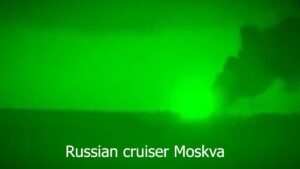
At the end of the day, it’s also important to note that the explosion on the Moskva may not have been a missile, but just negligence on the ship itself. Still, it’s patrolling the Odessa theater which is where a naval action will take place if there is to be one. In fact, if you look at the predictive models from the last post on the topic, the invasion of Odessa was supposed to happen in the first week of the war. This was to link up with Russian assets in the west and perform a pincer across the entire country. Now that this strategy is completely off the table, it’s not clear what Russia can really gain with an amphibious assault on Odessa. The question is why night footage of the ship burning, within range of Odessa, was possible if the ship was a safe distance out at sea.
Frigates Need Peacetime
It goes without saying that a ship with similar power and presence cannot be constructed during the War in Ukraine. However, it’s likely that Russia may never be able to construct a replacement, even after the war. If you look at the losses in ground-based systems, and open up the MUD construction menu, it tells a dire tale. It would take a high production city, one probably needed to keep its ground forces operating, almost a year and a half of in-game construction time to build a new replacement frigate. If you consider how realistic this is in real life, a Moskva replacement will be at least 10 years out, and that is assuming a wartime economy exists for that entire duration. Russia may never be able to recoup the loss of this ship if it wants to rebuilt the rest of its military.
That means it is imperative that the ship not sink (EDIT: It sank since the writing of this post). Using a dock with the possibility to reconstructing the ship is the only chance Russia has to get a frigate back in the game before the war ends. However, it’s still unlikely that Moskva will ever see combat in Ukraine again. If we use MUD’s analysis, the repair time for the Moskva will be somewhere between 5 to 212 days, if it can afford to fully dedicate funding/time to the operation. Even if the ship sees service again, the Russian Navy is likely to keep the ship out at sea immediately following this incident. That would also mean keeping Moskva away from the combat zone and use it for propaganda purposes only. That kind of mentality means it will be a bad use of what limited materials Russia has right now, since it needs systems that can directly impact the war on the ground immediately.
The situation with the Russian Navy is a demonstration of why Buy Points are so important in MUD. It is far easier to get a pre-built ship geared up for a battle than it is to construct a new one during a wartime event. However, at the same time it’s important to protect those assets because once they are lost, they cannot be re-built in time to be effective. Before the War in Ukraine, the best example of this was the Kido Butai and the inability to re-build it’s expensive carriers after Midway. But these two naval losses re-affirm that this important military consideration exists even for modern conflicts.

